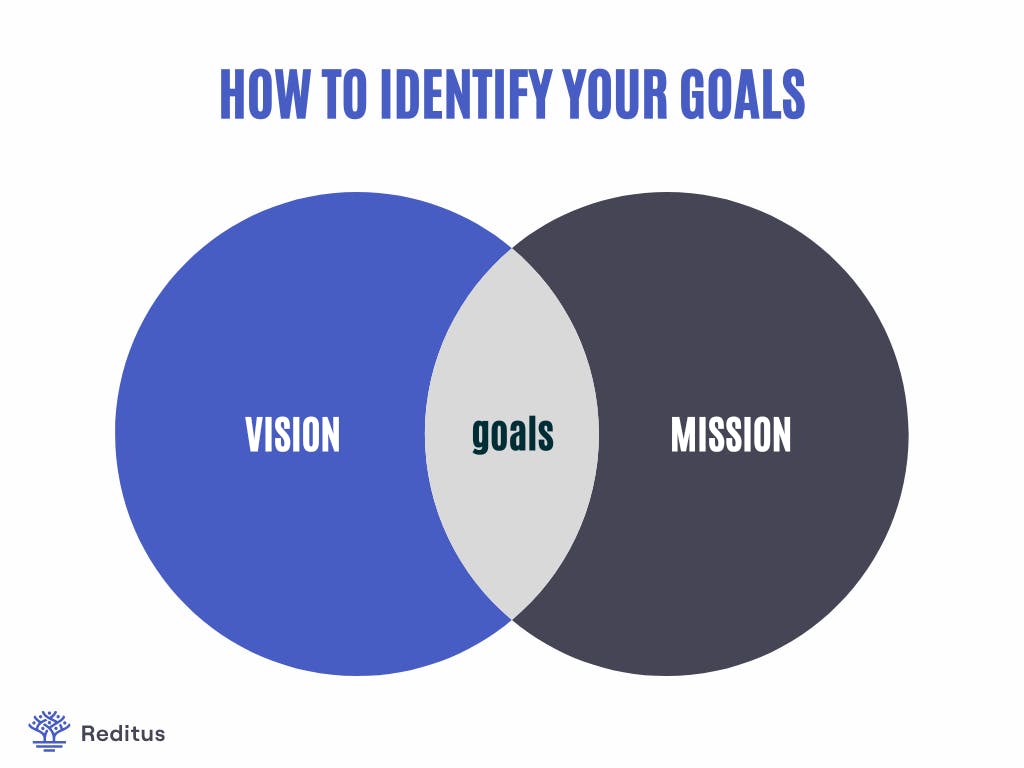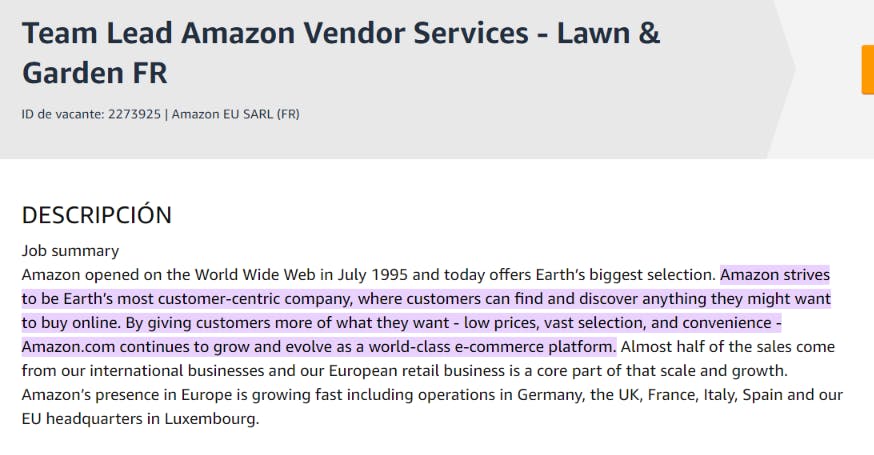SaaS Growth 101: Build a Business Around Your Vision

When it comes to growing a SaaS company, most founders and executives pay excessive attention to marketing, sales, and product development, while giving much less thought to their company's vision.
This is a mistake.
Your vision is the cornerstone of your SaaS company. It's the reason you're in business, and it's what will guide you through the tough times.
The challenge is that most people don't know how to develop a powerful vision. So in this article, we'll share some tips on how to do just that.
We'll also explain why having a clear vision is essential for growing a successful SaaS company.
Table of contents
What Is a Company Vision?
A company vision is a statement that describes what you want to achieve as a business. It's the long-term goal that you're striving for.

Many people confuse a company vision with a mission statement. But they're not the same thing.
A mission statement is a brief description of what you do. It's focused on the present and more about how you operate.
A vision statement is future-focused. It's about what you want to achieve.
Think of it this way: Your mission is what you do today to realize your vision tomorrow.
Why Is a Company Vision Essential for SaaS growth?
There are three main reasons why having a clear vision is essential for growing your SaaS company:
1. It gives you direction
The biggest challenge facing any SaaS company is that there are an infinite number of things you could be doing at any given time.
Your vision is what gives you direction. It's the North Star that you can use to make all of your decisions.
For instance, if your vision is to become the leading CRM provider for small businesses, then that should inform all of your decisions, from the products you build to the marketing campaigns you run.
Besides, customers are more likely to buy from a company with a clear vision. They want to know that you're not just building products for the sake of it but that you're on a mission to solve a specific problem.
2. It motivates your team
A robust company vision can be a huge source of motivation for your team.
Your employees want to be part of something bigger than themselves. They want to know that their work is making a difference.
When you have a clear vision, it's easier to communicate to your team why their work matters and how it fits into the bigger picture.
Making them fully part of the growth of your SaaS.
3. It attracts investors
Investors are always looking for companies with a clear vision. They want to see that you have a grand plan for where you want to take the business.
Having a well-defined vision makes it easier to raise money because it shows that you're not just making things up as you go along.
How to Develop an Effective and Inspiring Company Vision
Now that we've explained why having a company vision is so important, let's look at how you can develop one.
Here are four tips:
1. Keep it simple
Your company vision should be concise and to the point. It should be easy for everyone in your company to understand and remember.
Instead of just listing off a bunch of things you want to achieve, focus on one or two specific goals.
- Facebook's vision is "to give people the power to share and make the world more open and connected."
- Google's vision is "to organize the world's information and make it universally accessible and useful."
- Uber's vision is "to make transportation as reliable as running water, everywhere for everyone."
As you can see, all of these vision statements are short, sweet, and to the point, but that doesn't mean they're not ambitious.
Make sure your company vision is something you can realistically achieve. It should be a stretch but not so far-fetched that it's impossible.
2. Focus on the future
Your company vision should be forward-looking. It should be something you want to achieve in the future, not something you're doing right now.
For instance, Amazon's vision is "to be Earth's most customer-centric company, where customers can find and discover anything they might want to buy online."

This is an excellent example of a future-focused vision statement. Amazon wasn't always the customer-centric behemoth it is today. This vision statement gave them something to strive for.
If you are unsure about the future, you can always look to your mission for inspiration.
Your mission is what you're doing today to achieve your vision. So, if your vision is to be the most customer-centric company, your mission might be something like "offering the best possible customer experience."
Keep your mission in mind as you write your vision statement. It should be something that excites you, and that you're passionate about achieving.
3. Make it inspiring
Your company vision should be something that inspires you and gets you excited about the future of your business.
It should be a rallying cry for your team, something that gets everyone on board with your mission.
Don't be afraid to dream big. The sky's the limit!
We've already seen some great examples of inspiring vision statements, but here are a few more:
- "To make every home a happy home." (Home Depot)
- "To harness the power of the sun and turn the world into a more sustainable place." (SolarCity)
- "To make it easy to make the dental products you need without leaving your house." (Bazor Inc.)
- "To be the most loved fashion brand in the world." (Zara)
As you can see, these vision statements are all aspirational. They're not something the companies are doing right now, but something they want to achieve in the future.
4. Get input from your team
Once you have a draft of your company vision, it's time to get feedback from your team.
Show them what you've come up with and ask for their input. What do they think? Is it something they can get behind?
Don't be afraid to revise your vision statement based on feedback from your team. The more buy-in you can get, the better.
After all, your company vision should be something that inspires and motivates everyone in your business.
Potential Pitfalls To Avoid During the Process
Even though developing a company vision is essential for the growth of your business, there are a few potential pitfalls to avoid during the process.
Let's explore a few of them:
1. Don't make it too long
Again, your company vision should be short, sweet, and to the point. It's not an essay, so don't try to cram too much information into it.
The shorter, the better.
Some people believe that a company vision should be concise enough to fit on a bumper sticker. That might be taking it a bit too far, but you get the idea.
Even if you're not quite able to fit your vision statement on a bumper sticker, aim for something short enough that it's easy to remember.
2. Don't make it too narrow
While you don't want to make your company vision too long, you also don't want to narrow it down.
Some business owners make the mistake of creating a company vision that's too focused on one specific thing.
For example, let's say you own a software company. You might be tempted to make your vision statement like "To create the best software in the world."
Unless your company is the only one in the world that makes software, that vision statement is way too narrow.
A better approach would be to make your vision statement something like "To make it easy for people to get their work done."
3. Don't make it too vague
"Platitudes and generalities fall off the human understanding like water from a duck," said advertising legend Claude Hopkins.
In other words, don't make your company vision so vague that it could apply to any business in any industry.
For example, a vision statement like "To be the best" or "To be the most successful" is too vague.
What does it mean to be the best? Best at what? And what does it mean to be successful? Successful at what?
Aim for something specific.
4. Don't make it too aspirational
Having big goals and aspirations for your business is important, but you don't want your company vision to be so aspirational that it's unattainable.
Some business owners make the mistake of shooting for the moon with their vision statements, setting goals that are impossible to achieve.
While some companies have been able to pull off outrageous visions (like Elon Musk's company Tesla, which has a vision of "accelerating the world's transition to sustainable energy"), most companies are better off setting more realistic growth goals.
5. Don't make it all about you
Finally, don't make your company vision all about you.
Some business owners make the mistake of creating a company vision that's focused solely on their personal goals and objectives.
For example, a business owner might make their vision statement something like "To become a millionaire."
While there's nothing wrong with wanting to become a millionaire, that's not what your company's vision should be about.
You should focus your company vision on how you can help other people, not just on how you can help yourself.
A better approach would be to make your vision statement something like "To help people achieve their goals."
Keep these potential pitfalls in mind as you develop your own company vision.
SaaS Growth: FAQs
How can I make my B2B successful?
Once you have decided to start a B2B business, the next step is to devise a plan. A successful B2B plan should include market research, a marketing strategy, and a growth plan.
Market research helps you understand customer needs, preferences, and trends.
A marketing strategy can include creating a website, offering discounts, and engaging with potential customers on social media. It also includes the strategies you'll use to expand your customer base, improve customer service, and increase profits.
How can I speed up B2B sales?
To speed up B2B sales, it's essential to make sure you have a streamlined sales process. This means having a clear set of steps for each sale, including identifying prospective customers, reaching out to those customers, and closing the deal.
Additionally, an efficient customer service team can help close deals faster.
Automating tasks such as sending emails and communicating with customers can reduce the time required to complete a sale.
Finally, offering incentives to customers, such as discounts and free shipping, can help to speed up deals.
What are some typical B2B challenges?
Some of the most common challenges B2B companies face include:
- Finding the right customers: Identifying and targeting the right customers can be difficult, as it requires understanding their needs and preferences.
- Developing a robust sales process: A strong sales process is necessary to keep up with customer demands and close deals quickly.
- Building customer loyalty: Building customer loyalty requires excellent customer service and a great product or service.
- Keeping up with the competition: Staying ahead requires staying up-to-date on industry trends and technology.
- Overcoming cost barriers: B2B businesses must often overcome cost barriers, such as high prices and long delivery times.
- Meeting customer expectations: Meeting customer expectations can be challenging, as customers have high expectations for quality and service.
Conclusion
Developing a solid company vision is essential for the growth of your business.
Taking the time to create a vision statement will help you establish a clear roadmap for your business and avoid making common mistakes that can hinder your growth.
Remember to keep your company vision statement short, specific, and focused on how you can help other people, not just on how you can help yourself.
By following these tips, you'll be well on setting your business up for success.

